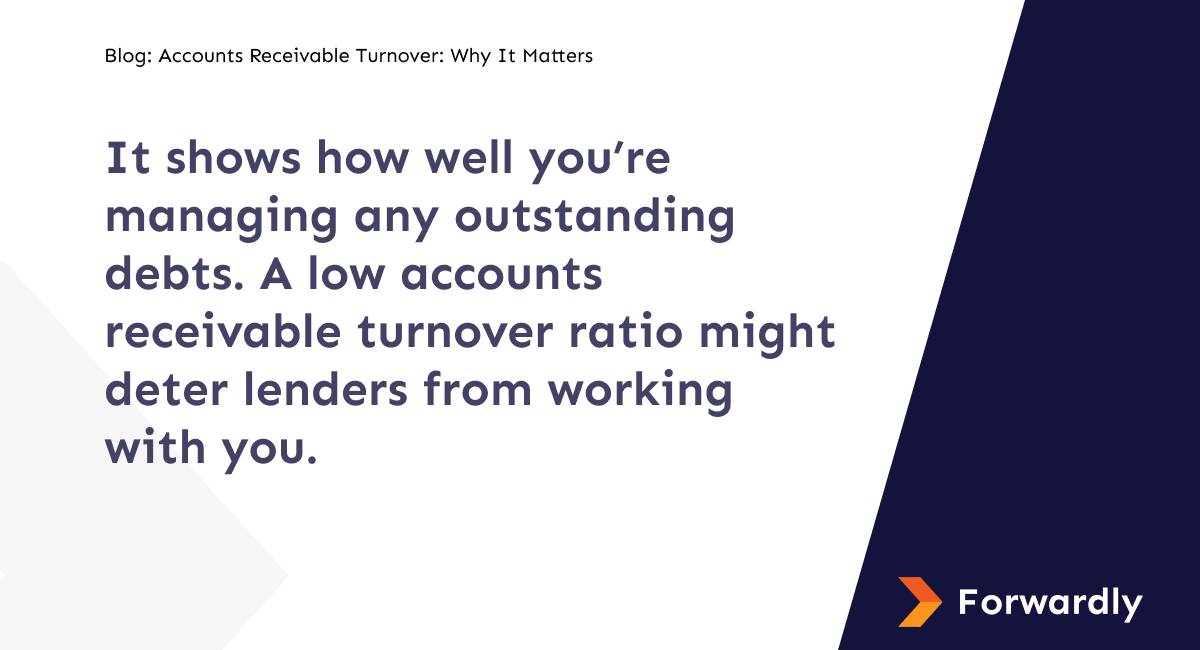As a business owner, you probably have numbers running through your head all the time as it is. It’s important to add another calculation to your list — accounts receivable turnover — to help complete your cash flow picture. We know how difficult it can be to stay on top of every sum, ratio, and forecast of your accounts, no matter how diligent of a business owner you are. That’s why we created Forwardly: to make it simpler for you to delve deeper into your finances rather than showing you your account balance and nothing else.
What’s accounts receivable turnover?
When you invoice a customer and set the terms of payment, you’re essentially creating a form of credit. Customer credit is a vital payment method for any business — it lets your customers buy goods or services from you now and fully pay for them later. Therefore, it can drive sales, but it can also be a detriment to your cash flow if some of your customers fail to pay in full, even with the time to do so.
Accounts receivable turnover analyzes just how well you’re dealing with outstanding customer credit. The simple ratio, also known as the accounts receivable turnover ratio or debtor’s turnover ratio, gives you an insight into how customer credit affects your business. Mainly, it points out how well you’re managing your customer credit relationships and collecting the proper payments on any outstanding debts your customers are carrying.

How accounts receivable turnover is calculated
Jot down this ratio — or bookmark this blog — so you remember it from now on:
Accounts receivable turnover = net credit sales ÷ average accounts receivable during the tracking period
Be sure you’re only incorporating your credit sales since cash payments have nothing to do with the effectiveness of your crediting scheme. This ratio is often calculated on an annual basis. However, it can also be measured on a quarterly or monthly basis.
An example of how to calculate accounts receivable turnover
The following is an example of how to calculate on an annual basis.
Let’s say Widgets Incorporated had $1,000,000 in accounts receivables as of January 1, the start of their fiscal year. On December 31, at the end of the year, they had $2,000,000 in accounts receivables.
Throughout the year, they had a total of $5,000,000 in net credit sales.
Step 1: To get the average accounts receivable, you follow the same formula that you would for any average. You add both numbers together and divide by two.
Average accounts receivable = ($1,000,000 + $2,000,000) ÷ 2 = $1,500,000
Step 2: Take the net credit sales and divide it by the average accounts receivable.
$5,000,000 ÷ $1,500,000 = 3.33
Step 3: Divide 365 (number of days in a year) by the accounts receivable turnover to see how long it takes an average customer to pay their bill.
365 ÷ 3.33 = 109.6
This means that the average Widgets Incorporated customer takes nearly 110 days to pay their bill. Clearly, this needs to be fixed. The company makes great widgets, but they’re a bit too generous with their payment periods and need to ramp up on collections.
How accounts receivable turnover is used
You can’t predict future sales or cash flow with 100% accuracy, but the accounts receivable turnover ratio gives you deeper insight into your business prospects. The ratio shows you how long it takes customers to pay their debts, which can help you plan your future expenses. By pinpointing any collections problems your company faces, you can boost cash flow back into the business. This will help you foster future growth for your company and focus your efforts on cultivating a client base that’s financially robust and responsible.
Why accounts receivable turnover matters
Your ratio can reveal whether or not your company has a good credit policy. It also shows how well you’re managing any outstanding debts. A low accounts receivable turnover ratio might deter lenders from working with you. Without available cash flow at the right points in time, how will you repay your debts?
If you’re unhappy with the ratio you find, you can implement new cash flow management strategies to boost your figures. For example, a low ratio might require you to impose more stringent penalties on late payments. Or, you could come up with a rewards program for those clients who always — or begin to — pay on time.
Evaluating your accounts receivable turnover
What’s a good turnover ratio and what represents opportunities for improvement? When it comes to the account receivable turnover ratio, the higher the number, the better. A sizeable figure can highlight plenty of good qualities about your business, including:
- You’re regularly receiving debt payments, thus boosting cash flow.
- Customers pay you back fast, which means they don’t have an outstanding line of credit and can buy more from you.
- You have a good customer base that adheres to invoice due dates rather than taking on debts
- Your collection system works well.
On the other hand, you might calculate your account receivable turnover to find a very small number after the equal sign. If so, your low ratio could indicate that:
- Your cash flow is low since your customers have lingering debts.
- Customers can’t make payments, which means they likely won’t buy again in the future.
- You have an overly lenient credit scheme.
- Your collection system is ineffective.
Once you figure out where you stand in this range, you can start making some of the improvements we talked about to your crediting plan. Or, if your system is already working well, you can keep moving forward. If you experience a cash flow shortage while you’re working on improving your accounts receivables processes, invoice factoring is one way to turn an unpaid invoice into cash.
Basically, it lets you sell the invoice to a buyer/lender so that you can get a set percentage of cash out of the invoice as quickly as possible. Instant payments can also help you prevent late payments, while p -p-authorized automatic payments can bring down your debtors to zero altogether. Don’t hesitate to check out modern payment solutions like Forwardly, which have all the features in one place for you to maintain a healthy cash flow.
How accounts receivable turnover affects cash flow
It’s clear how a positive accounts receivable turnover would boost cash flow. If customers are diligent about repaying their debts — and if you incentivize their behavior or penalize lateness — you’ll have more cash pumping into your company. On top of that, your regular customers will keep coming back, since they’re regularly repaying and re-opening their lines of credit. The more good payments you receive, the better your cash flow will be.
Cash flow is vital to your business— when money comes in on a reliable and regular basis, you can expand your reach and seize opportunities in countless ways. And, while the accounts receivable turnover ratio is one way to figure out how you can boost the amount of cash on hand, you will also benefit from a cash flow forecast from Forwardly. This report takes a deep dive into your accounts receivables to show you just how healthy your business is right now and how much it’s set to grow up to 12 months in the future. It helps you visualize your strongest suits, as well as the areas in which you can improve. If you’re a business owner, then there’s no better time than now to start forecasting and planning for the future.
Getting started with Forwardly
If you want to make your business’s cash flow healthier, give Forwardly a try. Forwardly is an all-in-one modern cash flow solution made for small businesses. It helps you get paid in under 22 seconds 24/7, simplifies your bill payments, and adds certainty to your business’s future.
With Forwardly’s two-way data sync, reconciliation workflows run smoother and more easily. It connects directly to leading accounting systems, making things more organized and efficient with automated reconciliation. And the best part? You save a lot on processing fees. If you’re looking to improve how you handle your business finances, Forwardly could be the answer. Sign up for free now.
This article is informational only and does not replace the expertise that comes from working with an accountant, bookkeeper, or financial professional.
 Back to Blog
Back to Blog


